If you’ve ever seen a condition where your child’s penis appears hidden or seems to sink inward, it may be a case of buried penis. This condition often worries parents because the penis looks abnormal, even though it actually exists and is of normal size—just drawn inward by the surrounding tissues.
To better understand what buried penis is, what causes it, and how it can be treated, here is the full explanation from dr. Hendy Mirza, Sp.U(K), a pediatric urology consultant at Mandaya Royal Puri Hospital.
Contents
Understanding Buried Penis in Children — According to dr. Hendy

Buried penis is a condition where the penis appears sunken into the surrounding tissue, making it look as though it does not protrude from the surface of the skin. According to dr. Hendy, this condition can be caused by two main factors: congenital (present at birth) and acquired factors.
“Buried penis is a condition in which the penis sinks inward. The cause may be congenital or acquired,” explained dr. Hendy.
In congenital cases, a child is born with the penis pulled inward. Meanwhile, in acquired cases, the causes can vary, such as chronic urinary tract infections, trauma, or complications after procedures like circumcision.
The most common cause of buried penis is in-elastic dartos tissue, a layer of tissue beneath the skin that supports the penis. When this tissue loses elasticity, it can pull the penis inward, making it appear hidden.
Treatment of Buried Penis in Children by dr. Hendy at Mandaya Royal Puri Hospital
To treat buried penis, dr. Hendy explains that the medical approach involves penile reconstruction surgery. The goal is to release the tissue that pulls the penis inward so that it can return to its normal appearance and function.
“In penile reconstruction, the first thing we do is excise all the in-elastic dartos tissue that pulls the penis inward. Once the penis appears, we then close the skin,” said dr. Hendy.
This procedure is generally safe and produces excellent results. Patients are usually hospitalized for two to three days and can go home afterward. Within about a week, the child can return for follow-up and resume normal activities.
dr. Hendy also emphasizes the importance of early detection by parents:
“If we feel our child looks abnormal—too small, the urinary opening looks unusual, or the testicles appear irregular—it’s best to consult a urologist,” he advised.
With proper medical examination, the doctor can determine whether the condition is buried penis, micropenis, or another issue such as trapped penis, allowing parents to receive an accurate diagnosis and the most appropriate treatment plan.
Profile of dr. Hendy Mirza, Sp.U(K)
dr. Hendy Mirza, Sp.U(K) is a urology specialist and pediatric urology consultant who focuses on reconstructive and laparoscopic urology. He completed his medical degree at the Faculty of Medicine, University of North Sumatra, and pursued his Urology Surgery specialization at the University of Indonesia.
To further enhance his expertise, he completed a fellowship in Pediatric Reconstructive (Laparoscopic) Urology at the University of Indonesia. With his extensive experience, dr. Hendy has handled various pediatric urology cases such as buried penis, congenital urinary tract anomalies, and post-surgical reconstruction.
His blend of academic excellence and clinical experience makes dr. Hendy one of Indonesia’s leading pediatric urologists—known for his modern, precise, and compassionate approach in providing holistic care for children.
Clinic Hours of dr. Hendy Mirza at Mandaya Royal Puri Hospital

dr. Hendy Mirza, Sp.U(K) is available for consultations at Mandaya Royal Puri Hospital during the following schedule:
- Monday: 16.00 – 19.00 WIB
- Wednesday: 16.00 – 19.00 WIB
- Friday: 16.00 – 19.00 WIB
For your convenience, appointments with dr. Hendy can be made easily through WhatsApp Chat, the Book Appointment feature, or via the Care Dokter application—available on Google Play and the App Store—to help you manage queues, access complete information, and streamline your hospital visit.



